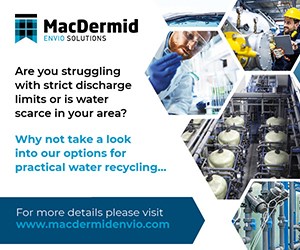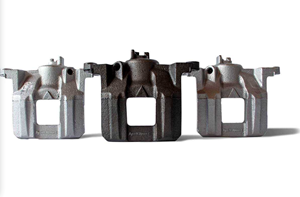Plating with Zinc-Nickel: Benefits and Challenges
Chad Murphy of Columbia Chemical speaks about the benefits of various types of zinc-nickel alloy, and provides tips for manufacturers about the zinc-nickel plating process.
Share

Q. Can you explain the benefits of zinc-nickel and provide an overview of alkaline versus acid zinc-nickel?
A. Zinc-nickel has increasingly become the finish of choice for many industries with high-corrosion and high-performance needs. It is a rapidly growing segment of the electroplating market, nearly quadrupling in usage in the last five years. The alloy has many properties that are appealing to manufacturers within the fastener, casting, automotive and heavy equipment industries. It is also gaining usage in the defense industry as a potential replacement for cadmium. Zinc-nickel offers superior corrosion resistance, with most deposits at a 12-to-15% alloy range producing a coating that can achieve 250+ hours to first white corrosion and 1,000+ hours to first red corrosion.
Hardness, heat resistance and high-alloy benefits
Zinc-nickel has a Vickers hardness of 400 to 500 HV — zinc-only deposits only have a hardness of around 100 HV. Because handling and assembly can be a destructive process for softer coatings like zinc and zinc flake, zinc-nickel’s combination of hardness and overall corrosion protection make the alloy deposit ideal for fasteners or components that require further handling or assembly.
Another excellent benefit of the zinc-nickel alloy deposit is its overall resistance to heat. Many industry specs require baking, and the zinc-nickel deposit can withstand baking temperatures in excess of 200°C for four hours while still achieving 800 hours of neutral salt spray protection to first red rust. Zinc-nickel is commonly used on stampings and fasteners for barrel applications, and heavily used on brake component castings in rack applications.
Most available zinc-nickel systems produce a similar alloy deposit, with an average alloy range of 12-to-15% nickel content. Early systems included a lower alloy of 5-to-7%, but those systems are obsolete. The chemical technology available in today’s higher-alloy systems produces a bright and ductile deposit with an even thickness and alloyed distribution over a wide current density range. Zinc-nickel is also the best coating choice when a black appearance is needed in the finished part, as the nickel in the alloy suits blackening.
Alkaline vs. acid zinc-nickel
Between alkaline zinc-nickel and acid zinc-nickel, alkaline zinc-nickel has a much larger market share — though acid zinc-nickel is rapidly gaining ground. Two main benefits of the alkaline zinc-nickel process are even distribution and ductility. Alkaline zinc-nickel offers a more even distribution across the current density ranges, making it ideal for plating complex geometries. The superior ductility of the deposit helps minimize cracking to maintain proper corrosion protection. As a result, manufacturers can subject alkaline zinc-nickel deposits to bending or crimping operations after plating. This is one of the primary reasons the automotive industry heavily uses alkaline zinc-nickel for brake lines.
One major benefit of acid zinc-nickel is that it provides superior activation compared to alkaline. This makes acid zinc-nickel a highly preferred method for plating over castings and other high-carbon, heat-treated steel components like calipers. In addition, acid zinc-nickel offers faster plating speeds due to its high efficiency, and acid zinc-nickel systems’ general ease-of-use at a wide array of current densities provides plating shops increased flexibility. Platers can run an array of current densities and still get a good part.
New solutions for acid-zinc nickel difficulties
There are several important operational considerations to keep in mind when running an acid zinc-nickel process. When not in use, anodes must be removed and cleaned prior to reuse. Older technology systems also require dual anodes and dual rectifiers, resulting in added cost and maintenance. Newer systems can operate on a single rectifier with specific adjustments to the anode ratio.
Another important operational factor to consider when evaluating an acid zinc-nickel process is the amount of total chlorides in the system. In the past, platers frequently experienced issues with ammonium chloride and high salt content in the process, which resulted in harder-to-control parameters and required constant elevated temperatures to stop the baths from salting out. The higher-salt solutions could clog air lines, filters, anodes, heat exchangers and cooling lines, meaning the bath would often need costly maintenance downtime in the form of decanting or pumping out and cleaning to remove the precipitate.
Fortunately, newer acid zinc-nickel systems can operate at lower, more economical temperatures compared to the high-salt systems. These newer processes are lower in total chlorides and offer a large operating window in the temperature range to eliminate the common problem of the bath salting out if it cools down. The lower operating temperatures also reduce unnecessary energy costs. Check with your chemistry supplier to ensure the process you are evaluating utilizes the newer technology with lower chlorides to avoid the issues mentioned above.
Looking to the future
Due to its high corrosion protection and heat tolerance, zinc-nickel offers many benefits and meets the demanding specifications of automotive, heavy equipment and similar OEMs. These industries will continue to serve as catalysts for growth and opportunity.
An important factor for success when plating alkaline or acid zinc-nickel alloys is working with a chemistry supplier who deeply understands the characteristics of alloy components and the different “levers” the supplier can pull to dial in the chemistry to your specific plating needs.
Related Content
Possibilities From Electroplating 3D Printed Plastic Parts
Adding layers of nickel or copper to 3D printed polymer can impart desired properties such as electrical conductivity, EMI shielding, abrasion resistance and improved strength — approaching and even exceeding 3D printed metal, according to RePliForm.
Read MoreTroubleshooting Alkaline Zinc
One of the most common problems that can arise when plating with alkaline zinc is an imbalance of brightener in the solution. In this helpful Ask the Expert article, Chad Murphy of Columbia Chemical discusses how different zinc metal concentrations and brightener concentrations can impact efficiency.
Read MoreProducts Finishing Reveals 2024 Qualifying Top Shops
PF reveals the qualifying shops in its annual Top Shops Benchmarking Survey — a program designed to offer shops insights into their overall performance in the industry.
Read MoreRead Next
Education Bringing Cleaning to Machining
Debuting new speakers and cleaning technology content during this half-day workshop co-located with IMTS 2024.
Read MoreMasking Solutions for Medical Applications
According to Custom Fabricating and Supplies, a cleanroom is ideal for converting, die cutting, laminating, slitting, packaging and assembly of medical-grade products.
Read MoreDelivering Increased Benefits to Greenhouse Films
Baystar's Borstar technology is helping customers deliver better, more reliable production methods to greenhouse agriculture.
Read More





















